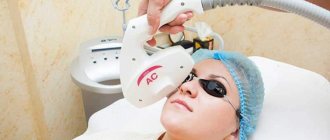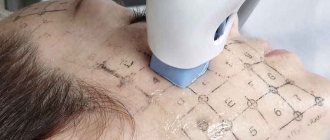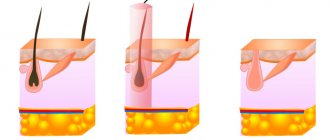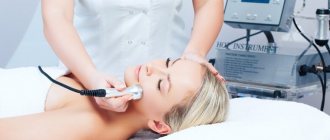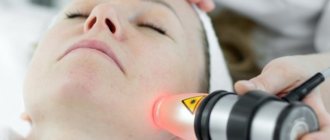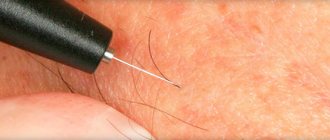Methods
The procedure has several ways of carrying out:
- Thermolysis is the use of alternating high-frequency current. The heat generated is directed directly at the hair follicle using a needle, resulting in its destruction.
- Electrolysis - a needle penetrates the hair follicle, a direct current acts - under its force, a sodium ion appears, which reacts with the fluid of the follicle tissue and destroys it.
- Blend is a combination of thermolysis and electrolysis. The method requires less time and shows greater efficiency.
- Sequential blend differs from the blend method only in the lower-frequency pulse of current amplitude, which reduces pain.
- Tweezers method - each hair is fixed with an electrode in the form of tweezers, and an electric current is transmitted through it, like a wire.
- Flash is an advanced thermolysis that uses direct current at very high frequencies to reduce pain.
- Sequential flush - uses alternating high-frequency sinusoidal electric current. This adds maneuverability to the electrode, allows you to remove hair of varying thickness without reconfiguring and increases the rate of destruction of the hair follicle.
With electrolysis, all options for regular hair removal are available - you can remove hair along the edge of the area, under a swimsuit or underwear, make a Brazilian version (popularly known as a deep bikini), partial removal anywhere in the bikini area, or even create designs from the hair. However, it is worth remembering that the pattern cannot be changed, only the hair can be removed completely.
Types of intimate hair removal: classic and deep bikini ↑
Removing unwanted hair from the sensitive area can affect different areas.
- Simple or classic bikini hair removal
Quite a common procedure. It is performed as follows: the client puts on small panties that cover slightly smaller areas than a swimsuit. And the master epilates the areas protruding beyond the edge of the underwear. The undeniable advantage of such electrolysis is the high speed, lower cost of the procedure and moderate pain, which allows some girls to refuse local anesthetics. From a medical point of view, such hair removal is preferable, because The most delicate areas are not affected.
Electrolysis gives the intimate area a neat and well-groomed appearance
- Deep bikini, also called Brazilian
This is complete hair removal from the intimate area. This procedure involves the destruction of hair follicles on the pubis, inner thighs, labia and around the anus. Sometimes, at the client’s request, a small patch of hair is left on the pubic area. Electrolysis of a deep bikini is quite painful, in most cases it is performed using various local anesthetics. The procedure can only be carried out by an experienced doctor who can choose the optimal hair removal method and perform the job efficiently.
Advantages and disadvantages
The main advantage over laser, photoepilation or other types of hair removal is that after treatment with electric current, hair will never grow back. It won't get damaged, get thinner, or die over time, it just won't grow back.
But this is not an exclusive advantage:
- Removal of hair of different colors and thicknesses. Thus, gray and very light hair, vellus hair, cannot be treated with laser hair removal.
- Applicable to men and women.
- curved are destroyed by electrolysis .
- ingrown is reduced .
- It is considered the most secure of the hardware methods.
- When performed correctly, there is no feeling of discomfort after the session.
- The skin quickly regenerates without any marks.
- The price category is accessible to almost all segments of the population.
- Suitable for all types .
- The procedure has the longest-lasting effect of no hair growth used in cosmetology.
- It can be used not only in the bikini area, but also on any part of the face and body, except for the armpits due to the proximity of the lymph nodes.
- The tweezers method can be used for areas with particular sensitivity (deep bikini, upper lip, neck).
On this topic
- Electrolysis
Pros and cons of electrolysis
- Inna Viktorovna Zhikhoreva
- October 15, 2020
There are disadvantages to each type of electrolysis:
- Painful sensations from electric shocks. (With a high pain threshold they are not felt). The skin in the bikini area is very thin and delicate, so you need to be prepared for unpleasant sensations.
- Electrolysis of the bikini area using electrolysis takes a very long time.
- With curved follicles, the needle may miss and affect the tissue near the bulb, and not the bulb itself.
- The procedure may not cope well with deformed bulbs, which will increase the number of sessions.
- The long stretch of time from the start of sessions to obtaining the desired result is sometimes annoying.
- The tweezer method is not used for areas with thick hair, as it takes about two minutes to remove one.
Many of the advantages and disadvantages of the method are purely individual and strongly depend on the methods of hair removal performed previously, the properties of the skin and the capabilities of a particular organism.
Electrolysis of mustache above the upper lip
The electrolysis procedure is used to remove hair on any part of the body, including the mustache above the upper lip. During electrolysis, hair follicles are destroyed. Sometimes a few sessions are enough to forget about the problem forever.
Preparation
Preparing for the procedure will not take much time, and for some it will even simplify daily hygiene, since you cannot use wax strips or an electric epilator, and shaving your hair is also prohibited. To successfully complete the procedure, a hair length of 2 to 5 mm is required, so you need to either shorten what you have or not shave for several days.
General recommendations for preparation:
- Do not take hormonal medications for about a week. When taking hormonal contraceptives, it is best to carry out the procedure after the end of your period and before starting a new cycle of pills.
- A week before the session you should not visit baths, saunas, solariums or sunbathe on the beach.
- On the day of the procedure, during morning hygiene procedures, you should treat the skin in the planned intervention area with a scrub.
- A few days before the event, examine the treatment area and eliminate ingrown hairs without pulling them out.
With proper preparation and following the recommendations, hair removal will take place with minimal consequences, or even without them at all.
Skin after electrolysis – what is normal and what is not
Last update: 12/27/2019
What a nightmare! How my face was blown apart after the procedure, there was no living space. And then there are some red dots, crusts. And how can I now show myself to honest people? I wonder how long all this will last? What if it's forever? So I removed a couple of hairs. It’s my own fault – I decided to finally deal with the vegetation. I could keep pulling!
Quite a few clients will find such a monologue painfully familiar. It’s also good if we are talking about a hidden area, but what to do with the face – you can’t really hide it.
A frantic search begins on a wide variety of sites, forums, conversations with all-knowing friends who must certainly give advice.
All this is followed by active self-medication with a wide variety of lotions, rubbings, folk remedies and a solemn promise to quit this terrible treatment forever!
Aggressive methods of such therapy often provoke real complications on the surface, the addition of inflammation with other unpleasant phenomena.
And if someone told our good friend that everything was quite fine with her, and she just needed to give her body the opportunity to put itself in order, there wouldn’t be many difficulties. This is what we will do below.
Let's try to figure out what happens after the session. Why do we see this or that picture? Is this normal or is it time to sound the alarm? And, of course, what to do with all this?
Photos from our collection
Electrolysis is a controlled trauma to the skin
Let's start with the understanding that eliminating vegetation with current is aimed at the complete destruction of not only the bulb itself, but also the nearby stem cells, as well as the tiny capillaries that feed the entire structure.
In a word, the task of electrolysis is to destroy the “unwanted enemy” in the bud in the literal sense of the word.
It may be the formation of alkali or scorching heat, but the result will be the same. That is, there is a slight and controlled trauma to the skin.
Therefore, expectations of a flawless and dazzlingly beautiful appearance after treatment will not only not be justified, but should not be.
Why? Because if after the session you left the specialist’s office looking “beautiful”, it means that most likely the treatment was in vain and the money was wasted.
The parameters were set incorrectly and the elements were not processed properly. It is important for us to see traces confirming healing and restoration of the tissue.
But what determines the degree of their expression, duration of existence and quantity?
- Location. According to the law of meanness, everything will be more visible on the face than, say, on the lower leg. This happens not only due to openness, but also due to greater sensitivity, active blood supply and densely populated vegetation.
- Healing ability. Here, too, sometimes it can be a shame - everything on your neighbor heals instantly, but your tiny pimple just doesn’t want to go away, and will definitely leave a stain behind for many weeks. General health and hydration will play a significant role in the speed of regeneration.
- Type of electrolysis. It is known that electrolysis is less painful and more gentle compared to its counterparts.
- Duration of the procedure. Everything is clear here - the more specimens destroyed, the stronger the injury and the more noticeable the reaction.
- Frequency of clinic visits. It’s also quite logical - the more often the visits, the less time the body has to heal itself.
- Climate. What does this have to do with it? But in a hot and humid area, a person sweats more actively, and accordingly, there is a high chance of bacteria attaching and infection. In such weather conditions, the entire healing process will take longer.
- Cloth. Carefully covered with many layers of matter, the impact zone will experience friction, which, in turn, will interfere with recovery. The same reason often leads to the development of inflammation.
- Your behavior before and after treatment. We are not talking about moral character at all, but about self-care. Following important recommendations will minimize any manifestations.
Having understood the factors that directly influence the manifestation of the consequences, now it is time to clarify the critical issue - the difference between the norm and the complication.
The difference between normal and complication after electrolysis
Removing the sprout permanently
Just like that. Hair will never grow again. And this is the main side effect. Whether this is normal or not is up to you to decide.
Pain
What's expected? A slight burning sensation, a “pinching” sensation, a “rubber band” click. All sensations should cease immediately after exposure. Severe and acute pain, intense burning indicate incorrectly set parameters. Let your treating cosmetologist know about this immediately.
Redness
That's how it should be. The injured area needs an active influx of ingredients for recovery. In response to this demand, local blood vessels dilate, facilitating the flow of components for the construction of new structures.
Externally, this is expressed as a change in color. The duration of this reaction is quite individual: from half an hour to a day.
In addition, a similar phenomenon can also be caused by an allergic reaction to the material of the needle probe.
In such a situation, you will probably also experience varying degrees of itching. Using gold tips will help resolve the issue.
What to do? Good old ice will come to the rescue due to mild pain relief and vasoconstriction. Antihistamines are a good solution in case of intense itching.
Edema
The mechanism of occurrence is the same as above, but the vessels react at a deeper level, increasing blood flow.
Externally, these may be limited “pimples” around the mouth of the hair, or, in the case of sensitive characters, the entire treatment area swells.
This can all last from several hours to a day after treatment.
Sometimes, due to increased blood flow, small vessels cannot withstand the pressure and are damaged. This will appear externally as a bruise.
What should I do? Despite the seemingly scary picture (some people think they look like monsters), this is still the absolute norm.
Ice compresses will come to the rescue. It is also important to calculate the time so that you do not have to rush headlong to an important public speech or an important meeting.
If the hair mass is thick enough, the cosmetologist may begin by thinning it to minimize inflammation. This is especially important for therapy on the face.
Crusts
More popularly known under the code name “sores”. At this point it is important to understand one point.
The next day after a visit to your favorite specialist, whitish-yellow elements like acne may pop up. Representatives of oily skin are given similar gifts.
This is nothing more than the contents of the sebaceous glands on the surface. After washing, they disappear, giving way to “lids” that protect the wound from pathogens.
These “comrades” need to be protected. Ripping them off is fraught with unpleasant consequences in the form of infections, pigmentation, and even scars.
But the use of healing compounds like Bepanten, Panthenol and others is very desirable.
Bruises
We have already found out one reason for the appearance of these “beauties”. Another culprit would be the impact of the blood capillary feeding the root.
Another factor may be a specialist who has gone into a frenzy and is trying to fix the tissue too intensively. This should not be the case, and the person in charge needs to reconsider the strength of their pressure.
Salicylic acid preparations (aspirin) promote bleeding and will increase the chances of getting a similar picture.
Naturally, it will take some time for the spot to lighten. Preparations with arnica extract will speed up the process.
Dryness, itching
A small number of people may notice this effect after using electrolysis. This is due to the effect of alkali on the epidermis. At this stage, all care products should be as gentle as possible, without alcohol, fragrances and other aggressive substances.
The appearance of herpes
Of course, electrical interventions, if all standards are observed, can in no way “reward” a person with the virus, but can intensify an existing infection.
The use of antiviral ointments before the visit will reduce the likelihood of the formation of herpes elements.
Scarring
Replacement of normal skin with fibrous tissue. Occurs when there is excessive trauma, when the body is no longer capable of normal regeneration.
With proper treatment, this outcome is completely excluded.
Scars indicate incorrectly set parameters and inexperience of the treating specialist.
Tearing off crusts, improper care, and the addition of bacterial flora have a similar effect. We will be able to see real scars only after 6-12 months.
Pigmentation disorder
Discoloration may occur in those with sensitive skin. There is a term - post-inflammatory hyperpigmentation.
Surely you have witnessed the healing of a pimple, which was gradually replaced by a rather stable spot.
The same mechanism is present after electrical intervention.
But there is good news - the surface will return to normal after a certain time. Restoring normal color may take from 3 months to 2 years.
The use of acid peeling under the careful supervision of a professional can significantly speed up the process.
Interestingly, in dark-skinned individuals, the color can change towards lightening.
Photos from our collection
Progress of the procedure
To carry out the procedure itself, different needles are used:
- for women with a low pain threshold - needles made of nickel-chromium alloy;
- for normal and high thresholds - Teflon-coated needles;
- for delicate skin prone to rashes and allergic reactions - golden needles.
On this topic
- Electrolysis
All about electrolysis of the upper lip
- Inna Viktorovna Zhikhoreva
- June 14, 2020
After selecting materials, work begins with the declared zone.
- The bikini area is treated with an antiseptic to prevent bacteria from entering the follicles.
- Anesthesia is performed with a cream or an injection with a local drug is given. (Carrying out the procedure after menstruation will also reduce pain). Allergic reactions to components of painkillers should be warned in advance. You also need to know that the thinner the skin and the closer the location of the hair follicle to the nerve ending, the more painful it is. That is, even an injection of painkiller does not always relieve discomfort.
- Then the procedure itself is performed. During it, be sure to hold the electrode in your hand, which will be given by the cosmetologist. This will protect against electric shock when affecting the bulbs and follicles.
- Treated hairs are removed Tweezers are used and the process is completely painless.
- is re -treated with an antiseptic to minimize the risk of infection and skin irritation.
At the end of the procedure, you need to dress carefully, without disturbing the bikini area, and familiarize yourself with subsequent skin care; many cosmetologists provide instructions on this topic.
How to prepare for electrolysis in the bikini area?
The procedure does not require any special preparation. But there are several tips that will make hair removal more effective and will not cause complications.
- Before the procedure, hair in the bikini area should be shortened. They must be no shorter than two and no longer than five millimeters. Thanks to this, the session will go faster and better.
- Before electrolysis, you should not use hair removal methods such as waxing or using an electric epilator. This will lead to deformation of the hair follicle, which will significantly complicate the work of the cosmetologist.
You can shave your hair or lighten it, but no later than two days before the procedure.
- About a week before the session, you should stop using hormonal medications.
- A few days before the procedure, you should not go to the bathhouse or sauna, sunbathe or visit the solarium.
- On the day of the session, all necessary hygienic manipulations in the bikini area should be carried out. It is advisable to treat the skin with a scrub.
- Trust the procedure only to an experienced cosmetologist with a medical education. Hair removal should be done in a clinic using professional equipment. This will reduce the risk of complications.
Bikini area hair cannot be removed in one go. This is due to the fact that initially the effect extends to the hair follicles that are in the growth phase. But hairs in the resting stage will continue to grow for several months. In order to completely remove hair from the bikini area, several treatments will be required approximately every two months.
Reviews from girls say that following these simple tips will help you achieve the desired result without complications.
The electrolysis procedure itself takes place in several stages:
- To begin with, the skin in the bikini area should be treated with an antiseptic.
- If necessary, local anesthesia is administered. The procedure is quite painful, so you can apply a special anesthetic cream or give an injection. The session should be performed immediately after menstruation. This will also reduce pain.
- Next, the hair follicle is directly exposed to electric current. To protect the client from electric shock, she is given an additional electrode. It must be held in your hand throughout the entire session.
- Use tweezers to remove damaged hairs.
- To avoid infection, the skin is again treated with an antiseptic.
Skin care after the procedure
In order to minimize discomfort after electrolysis, you need to carefully care for your skin and follow some recommendations:
- Treat the area disinfectant (chlorhexidine or alcohol solution) several times a day. Calendula tincture lotions are also suitable.
- Do not visit the gym , sauna, bathhouse, swimming pool, or take a bath for 24 hours after the session.
- Do not scrub your skin during hygiene procedures.
- Avoid deodorants, talcs, and creams for several days.
- Do not rub or scratch itchy areas.
- Do not visit a solarium or use self-tanning for two weeks.
If you follow these recommendations, all the consequences will disappear and the skin will be completely restored within a week.
Consequences
The consequences of electrical hair removal can be not only positive, but also negative. Manifestations such as swelling, bruising, scars (signal about incorrect selection of discharge power), reddish spots (quickly disappear), acne and itching in the bikini area (a natural reaction of the skin to exposure to electricity; scratching is strictly forbidden, as the itching will only intensify and may scarring) are called complications.
They are provoked by interference with the natural processes of hair growth, the actions of a doctor, or the skin’s own properties and reactions.
How and where is electrolysis done? How much does the procedure cost?
Due to the complexity of the procedure, it is recommended to choose specialized salons. It is best to avoid private hairdressers, as an unprofessional approach can cause more problems than unwanted hair.
The salon must be able to provide first aid if necessary. Therefore, the procedure must be carried out by a cosmetologist.
Electrolysis methods
Electrolysis is divided into several methods:
- Thermolysis - this method is an electric shock that occurs briefly. Under its influence, the bulb is destroyed. Before thermolysis, a person must be given local anesthesia. Only a professional specialist can carry out this type of hair removal. The technique requires precise placement of the needle into the bulb. Each hair takes a few seconds. This method is not used for hair removal in the bikini area.
- Electrolysis is the application of current at a regular frequency. Alkali appears around the bulb. You can tell that the bulb is being destroyed by the appearance of bubbles.
- Blend is a mixed type that combines electrolysis and thermolysis. Removal occurs in two stages. At the first stage, the bulb is heated, at the second it is destroyed and removed. This method is convenient because you can change the frequency of the current. In this regard, the blend is most often used to remove facial hair.
- Flash is a method of applying electric current with short flashes. It is used to remove hair in the armpit.
The cost of the service is calculated by the minute. The price per minute can vary from 8 to 50 rubles, it all depends on the qualifications of the specialist and the type of equipment used.
Don't miss the most popular article in the section: Laser hair removal on the face and body - how it is done, effectiveness, before and after photos, contraindications.
Contraindications
Each medical procedure has its own contraindications, and electrolysis is no exception:
- inflammation of the skin in the treated area;
- any types and stages of tumor development;
- epilepsy, mental disorders;
- pregnancy and lactation;
- viral and infectious diseases, as well as skin diseases, the course of which is provoked by stress;
- skin is prone to the appearance of colloidal scars;
- allergic reactions to metals and alloys from which the instruments for the procedure are made;
- diseases of the heart and blood vessels;
- a heart pacemaker has been installed ;
- the presence of metal objects or implants in the body;
- intrauterine device (for deep bikini treatment);
- hemophilia, hepatitis;
- varicose veins in the epilation area;
- hormonal diseases and disorders of the body.
If the presence of hair is caused by a hormonal imbalance in the body, the chances are quite high that any hardware hair removal will not help get rid of them, so you must first undergo treatment and only after complete recovery think about electric hair removal.
If any item from the above list is present, you should refuse the procedure or postpone it until the contraindications are eliminated.
The decision to permanently get rid of unwanted hair will free you from constant hygienic procedures for removing unwanted hair. The method and method of disposal should be chosen based solely on your capabilities, preferences and the presence of contraindications.
Before signing up for a procedure at a salon, you should familiarize yourself in detail with the methods, processes and all the nuances, as well as consult with a doctor and cosmetologist.
After consultations, you can take a trial session. Select a small area of skin, preferably invisible to others, and remove hair using electrolysis. After it, it will be possible to evaluate the aesthetics of the action, skin reactions, selection of current strength and all possible side effects and complications.
You should not try a new cosmetic hardware procedure on a large area at once, it will be expensive, and the effect may not live up to expectations. During a trial session, you can also evaluate pain and time, think about the size of the subsequent treatment area and your own sensitivity, besides, the result largely depends on the cosmetologist who performs the procedure.
Complications of electrolysis: about crusts, scars and age spots
The skin's reaction to electrolysis depends on many conditions.
In particular, this is the degree of moisture and oiliness of your skin, the thickness of the hair being removed, the density of its growth, the method of electrolysis, current parameters, post-procedure care and features of your health that you may not even suspect. I assume that you have already read my introductory article on electrolysis and know that moisturized normal skin is necessary for any method of electrolysis: in the case of direct current, the amount of saline fluid in the follicle determines the amount of alkali, in the case of alternating current, the heating temperature of the tissue at the end of the needle.
In addition, dry skin heals more slowly. Oily skin is not necessarily hydrated, but sebum is definitely an excellent insulator.
All this leads to the fact that the master will begin to increase the current parameters so that the impact is sufficient to extract the hair, while the lower and upper layers of the skin are more damaged and subsequently heal more slowly, sometimes with complications.
The next parameter is the growth characteristics of the hair itself. Typically, the finer the hair, the smaller the follicle and the lower amperage required for effective removal.
The less hair grows, the less likely there is to be an overlap treatment, where the high temperature treatment area of one follicle partially overlaps with the treatment area of an adjacent follicle.
This is especially true for the thermolysis technique, since in pure thermolysis the current values are usually higher than in the mixed blend method.
The material is illustrated with photographs from my archive and the archive of Joseph M. Reina, a specialist in electrolysis from Spain.
The text is written based on discussions by professional electrologists and using the book “Epilation Encyclopedia: Everything about Hair Removal for Professionals and Beauty Salons” by D. Morris, D. Brown. (M.
: RIPOL classic, 2008. - 400, ill.). Constantly updated.
Normal reactions:
- Erythema and edema
- Itching
- Red crusts (scabs)
- Whiteheads (hypopigmentation)
Atypical complications:
Normal skin reactions
In the video below, the author of the book on electrolysis, Michael Bono, talks about the stages of skin healing after electrolysis. If you speak English, you will understand that most reactions that are scary at first are a natural healing process:
Normally, after electrolysis, swelling and slight redness appear. Redness is a natural reaction of the body, meaning that blood has flowed to the area affected by the current and the healing process has begun.
Below are photographs of the normal skin reaction after hair removal on the arms and legs using the flash method. These reactions are largely individual and are more pronounced the more densely the hair grows.
The redness subsides very quickly: after 3-5 hours the skin acquires a normal color.
Redness on the legs Redness on the arms during the first cleaning Redness due to sparse hair growth Touching and swelling when epilating vellus hair on the back
Sometimes this reaction - dermatographism (urticaria) with redness or whitening of the skin - can be very strong, but it also goes away on its own after a few hours.
If you are one of those people who suffers from hives, then it makes sense to take antihistamines before electrolysis.
For these purposes, medications are used internally or antihistamine creams immediately after the procedure or as small areas of the skin are cleansed.
Swelling in many areas is also normal. It usually goes away on its own after a few hours; on particularly sensitive areas, like the upper lip, it can last up to 36 hours. To reduce swelling, apply ice in a plastic bag to the area, then apply hydrocortisone ointment (has contraindications!).
[Photo below taken from a transgender forum. The girl tells how she removed facial hair: “Two months ago I underwent the first procedure, and I had nothing - no red spots, no swelling, no redness, no pain. Then I met another electrologist.
She said that the method uses direct current and is dangerous, and chemical burns carry the risk of scarring.” Since classical electrolysis is no longer practiced by anyone, this terribly dangerous method, in the opinion of the second electrologist, is blending.
So, poor results and scars can be obtained with both methods, and the fundamental difference from a safety point of view is that direct current is not used if there are conductive implants in the body.]
Swollen chin immediately after the flash procedure (accelerated thermolysis) and six days later. In general, this is a normal reaction for the first time and you need to be prepared for it if you work with alternating current (thermolysis).
Itching
“Itching is a natural part of the healing process and is associated with the release of histamine,” writes Michael Bono in his book on electrolysis, noting that there are clients who are particularly sensitive to itching and may feel it during the procedure.
For example, I had such a reaction only at the stage of healing of the crusts. You may even accidentally scratch them (see below), which will slow down the healing of the skin.
To relieve discomfort, you can use sunburn remedy, aloe vera, or topical antihistamine ointments if you really can’t stand it.
Red crusts (scabs)
Immediately after the procedure, ichor (lymph) and even a little blood may be released from each hair pore. The dried liquid clogs the entrance to the hair pore, forming a scab - a yellow or red crust.
This is necessary to protect the wound from infection. For areas such as the arms, fingers, inner thighs, abdomen, nipples, armpits, and pubis, this is an almost inevitable reaction.
Conversely, crusts on the face rarely occur.
Usually the crusts dry out and go away on their own within a week. For the first few days, they should not be scratched or steamed, otherwise they will come off before new thin skin forms underneath. At the same time, the crusts must be protected from drying out, otherwise they will also come off too early.
If the scabs are torn off before new skin forms, healing will slow down and the general redness of the skin will take a couple of months to subside. This skin does not require any special care.
Red dots on the arm Red dots on the back
During electrolysis, the current acts at a depth of up to 5 mm, damaging the deep layers of the skin. This is why it is important to avoid sun exposure until the new skin behind the scabs is thick enough. One way or another, even if you break the regime a little, the effect of changing skin color will be temporary. The photo below shows a person’s back a few days after the first hair removal and a year after it:
Red crusts during hair removal on the back Back one year after the procedure
If you went for electrolysis immediately after tanning, then the next natural reaction is the appearance of white dots like these:
White spots after electrolysis
This is not inflammation or sebaceous plugs, as you might think, but areas of hypopigmentation. In reality, this is what your skin looks like without tanning. Over time, the tan will fade and the spots will darken a little under the natural sun. Eventually the color difference will disappear. It is important not to sunbathe on purpose at this moment, otherwise you can achieve the exact opposite effect.
Unusual complications
Next, we will consider complications that should not normally be observed. Most of these complications occur when the rate of healing of the deep layers of the skin is disrupted. These could be internal reasons, insufficient care leading to inflammation and infection of the skin, or a professional error (thermal overload of the skin).
Internal causes include conditions with a slow metabolism - for example, hypothyroidism, anemia, insulin resistance (diabetes). A common cause of inflammation, in addition to improper care, is increased skin sensitivity as a result of allergies in the active phase, burns, tanning, peeling, skin diseases (for example, psoriasis), vitamin A intake, etc.
The reasons leading to the formation of age spots include a lack of folic acid (Vitamin B9) and impaired liver function. If you have a lot of freckles, then your skin is prone to developing age spots.
Scars are composed primarily of collagen and are sensitive to ultraviolet radiation. Young skin is also sensitive to ultraviolet radiation, so after the wounds heal, they are covered with clothing or protected with sunscreen (SPF 50) to avoid discoloration of this skin.
Bruises
This happens if the technician gets into a capillary or does not stretch the skin when inserting the needle. There is nothing wrong with this, anyone can get into the capillary, but if this happens often, then perhaps the master is inexperienced. Normally, the needle is inserted along the hair follicle without damaging anything. Electrolysis is not performed on bruises.
Skin overheating and burns
Already at a temperature of 55°C, collagen damage is possible - this is very close to the operating temperatures during electrolysis.
Damage to collagen due to excess heat is one of the two main causes of scars and age spots. Let me show you what the skin looks like after overheating.
Here I had thick hair, which the master treated with excessive alternating current. Post-procedure care was standard + Panthenol ointment (pictured right after applying the ointment):
Thermolysis-electrolysis of the neck with excessive current parameters and too thick a needle
Infection and pus
The problem in the photo is not only the overheating of the skin, but also the fact that it happened in the fall, and after the procedure I did not end up at home by magic.
This photo shows that the skin began to heal, but instead of the normal red crusts, yellow ones with pustules appeared, which I successfully tore off - it seems, in a dream (itching is a natural reaction).
There is no need to do this! If the wounds become infected, use Levomekol ointment according to the instructions for it.
If you are prone to the formation of pustules, then immediately after electrolysis it makes sense to apply a warm compress to the skin and then lubricate with salicylic alcohol or tea tree oil.
If you have weeping wounds, treat with chlorhexidine or calendula tincture, then apply baby bactericidal powder. Just don’t get confused: the discharge of ichor immediately after the procedure is normal, but the discharge of ichor every other day is no longer the case.
Yellow crusts 3 days after the procedure even with Panthenol ointment
So, the second very common cause of complications is infection. Now I do it at home, the risk of infection is minimal, and usually my skin looks like this:
Before the procedure, 13:50 Immediately after, 14:47 At 15:20 The next day at 19:45
At the same time, I don’t apply anything at all or apply mint oil if it seems to me that the skin has become a little dry after drinking alcohol. What is the fundamental difference here? Firstly, this is a different method - blending, in which the heating of the skin is much less. Secondly, I do it at home and after the procedure I don’t touch the skin, I don’t wear scarves, sweaters, I don’t urinate or sweat.
Post-inflammatory redness
Small patches of redness on completely healed skin are also a common reaction, perceived as patches of hyperpigmentation, but in fact this is not pigmentation.
Such spots usually appear on dark leather even with proper treatment. I now have them due to skin overload (see below).
Usually, after cessation of exposure, the spots disappear within a few months (up to a year). They do not require any special care.
In addition to the redness, I had quite deep pink funnels - you can see them in the photo. I began to use “Kontratubex”, which was left over after an unsuccessful attempt to reduce a hypertrophic one-year-old scar from mole removal. I don’t know if the cream helped or if the scars would have gone away on their own, but in the end I don’t have any scars after electrolysis.
5 days after the procedure the skin looked like this. My hair had already started to come out, and two days later I went for the second and last procedure with that master.
Scarring (appearance of pits and bumps)
Pits and tubercles are scars, atrophic and hypertrophic, respectively. This complication is possible under the following circumstances:
- over-processing of the skin resulting in slow healing
- healing of skin with complications in the form of ulcers
- insufficient skin treatment, when the same follicle is processed several times
Years of waxing and other plucking techniques damage the deeper layers of the skin, which can also cause scarring. Often such pits and tubercles regress on their own within 1-2 years. Healing occurs faster with normal rather than dry skin, so you can apply vitamin E to your skin to prevent complications.
White spots after electrolysis on the back and shoulders. These are hypertrophic scars, they gradually disappear. Compare these spots with white dots against a tan (Photo taken from here)
If you have a tendency to form scars, use Contratubeks, Medgel, Dermatix (or others) ointment as soon as the wound is covered with thin new skin.
They are more effective if used in the early stages of scar formation. Mature scars (from 1 year) can be removed using physiotherapeutic procedures (electrophoresis, phonophoresis, ultraphonophoresis) or cryotherapy.
Atrophic scars (pits) are removed using peeling with enzymes or acids (carbolic acid, salicylic acid, fruit acids, etc.).
Dark spots
To avoid age spots after electrolysis, use sunscreen (SPF 50) and avoid exposure to the sun for 5-7 days after the scabs have disappeared, provided that healing has occurred without purulent inflammation. Otherwise, until the skin heals. Usually, electrolysis is paused for the summer. (I don't because now, as you saw in the photos above, I don't have any crusts).
In areas of the skin close to the mucous membranes (scrotum, labia, nose, anus, etc.) there is a greater likelihood of developing hyperpigmentation, but over time the skin color there evens out on its own.
Age spots on visible areas of the body are removed in the same way as freckles and age spots formed during pregnancy. At home, you can make masks with acids or enzymes - 2 times a week in a course of 10 procedures. Drink vitamin C, smear the skin with vitamin E. There are special cosmetic procedures using radiation from broadband pulsed lasers.
Blood poisoning
This is one of the most terrible complications, entirely dependent on the electrolysis specialist. Before doing electrolysis, make sure that the specialist has sterilized, inserted a new needle, etc.
Complications Related care Frequently asked questions Electrolysis Recommendations
Source: https://hairbug.ru/article/korochki-shram-pigmentny-pyatna-elektroepilyatsii-termoliz.html


